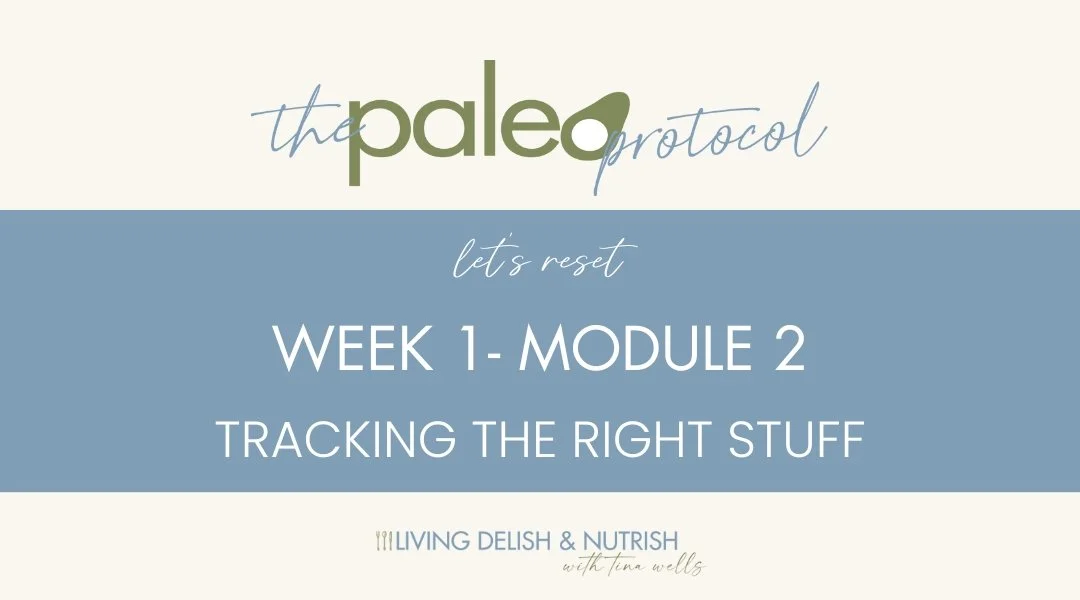Tracking the Right Stuff
During the Paleo Protocol, it’s my goal to help you break free from traditional diet culture. As I will mention many times, we are stepping off the scale, not thinking in terms of calories, and the only weighing or measuring we do is when we’re making a recipe.
One way to help ease you out of this mindset is to start to factor in other lifestyle benefits like meditation for stress management, a new bedtime routine, or a workout or movement routine.
Rather than thinking of these as another thing to factor into your already busy day, think about how you can incorporate them into what you’re already doing. If you have a long commute to work, or perhaps you’re waiting in the pick-up line at school, this could be a good time to do a breathing exercise or listen to a health podcast.
Chair yoga is a simple way to incorporate short bits of movement into your day between tasks at your desk. There are several videos available; choose one that suits you. Another idea I love to share is to put a small weight next to your coffee pot. Each time you refill your cup, do 5 bicep curls with each arm. 2 cups of coffee X 10 reps (5 per arm) X 5 days per week = 100 reps per work week! If you get creative, you will find all sorts of ways to fit in small changes, and they will have a big impact.
So while you are not tracking all of those typical metrics we are accustomed to tracking during a “diet”, you may, if you choose, track specific nutrients. These are protein, fiber, Vitamin D, healthy fats (omega-3 fatty acids) and magnesium.
Eating enough protein helps reduce belly fat. Aim for 1 to 1.5 grams for every kilo of body weight. An easy way to calculate this is to simply divide your weight in half. If you weigh 150 pounds, you should aim for 75 grams of protein each day.
Fiber:
Any type of carbohydrate that your body can’t digest is considered fiber. It leaves your stomach undigested and ends up in your colon, where it feeds friendly gut bacteria, leading to various health benefits. Certain types of fiber may also promote weight loss, lower blood sugar levels, and fight constipation. High fiber foods like fruits and vegetables tend to be lower in calories. Also, fiber’s presence can slow digestion in the stomach to help you feel fuller for longer. Psyllium husk is also a good source of fiber, as well as nuts and seeds. 10 grams of fiber each day is a good amount.
Vitamin D:
It helps your body absorb calcium, one of the main building blocks for strong bones. Together with calcium, vitamin D helps protect you from developing osteoporosis, a disease that thins and weakens the bones and makes them more likely to break. Your body needs vitamin D for other functions too. Your muscles need it to move, and your nerves need it to carry messages between your brain and your body. Your immune system needs vitamin D to fight off invading bacteria and viruses. Your body makes vitamin D when your bare skin is exposed to the sun. Most people get at least some vitamin D this way. However, clouds, smog, old age, and having dark- colored skin reduce the amount of vitamin D your skin makes.
Healthy Fats /Omega-3 Fatty Acids:
Consuming EPA and DHA directly from foods is the only practical way to increase levels of these fatty acids in the body. This is present in plant oils, such as flaxseed, olive, and avocado oils. DHA and EPA are present in fish, fish oils, and krill oils, but they were originally synthesized by microalgae, not by the fish. When fish consume phytoplankton that consume microalgae, they accumulate the omega-3s in their tissues.
Magnesium:
According to the National Institutes of Health (NIH), Magnesium is a nutrient that the body needs to stay healthy. Magnesium is important for many processes in the body, including regulating muscle and nerve function, blood sugar levels, and blood pressure and making protein, bone, and DNA. Magnesium is great for sleep and muscle relaxation, as well as digestion and elimination. Recommended Daily Allowance is between 300 and 400 mg, although some practitioners recommend up to 700 mg.
Be sure to download the Nutrition Tracker document for ideas on which foods to include so you can.

